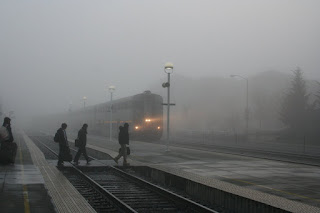Trains Part 1



We stood on the platform wrapped in heavy coats and gray fog, voices over the loudspeaker drowsy and damp sounding in the early morning rushhour. We heard the throaty whistle and the electrifying sound of thousands of tons of metal rushing over slender bands of steel, the engine car emerging with bright lights and blaring horns between the concrete platforms. Commuters rushed towards the oncoming train, a seemingly dangerous trajectory, but they halted at the yellow line, waited for the train to stop, then scurried aboard.
When the next train barreled into the station in Oakland, California, on a cold-for-California-but warm-for-well, almost-everywhere-else day in January, we lugged our assorted duffel bags and backpacks, purse, messenger bag, and guitar into the nearest car. My camera's shutter clicked as the industrial landscape of downtown Oakland, sharp corners and billowing smoke, blurred by.
In Emeryville we checked our bags and waited for our next train: The California Zepher.
The California Zepher. The Zepher. Even the name sounded old-fashioned and romantic.
Before J and I had decided to take the train across country, we talked with my friend Tim in San Diego about the idea. Actually, Tim may have brought it up and planted the seed by talking about his desire to train across the country dressed in 1940s garb, ordering liver sandwiches from the dining car and talking like Jimmy Cagney about the War. Because when was the last time people really needed to take a train across the country?
The uniformed attendant greeted us at the door to the sleeper car. The first class sleeper car, that's what it's called. Even if we were just in a Sleeperette. "I'm Pete," he said. "I'll be with you all the way on your journey to Denver. Can I take a bag? No? OK. Your room is on the top level, number seven. I'll come by in a little bit to tell you about your trip."
We giggled as we found our cabin in the narrow hallway and flopped down in the double wide seats. A Sleeper Cabin! We were going in style. Well, it's a sleeperette, which means its only half as big as an actual full sleeper cabin, but it was all ours! The two seats face each other and then slide together to form one bunk. The top Pullman bunk stays tilted up during the day but Pete would come to lower it into sleeping position later that evening, tucking crisp sheets behind the thick, strategically placed straps holding you in should the train attempt to catapult you off your mobile bed.
As I rearranged our bags on the Pullman for the day, J checked his I-Phone to look up tipping procedure. We had never had a cabin steward before, so didn't know what was included or how much to tip. Lo and behold, within the electronically frayed postings of an online bulletin board, J discovered that tipping five to 10 dollars per person per night is customary, but also that all meals are included in the ticket price! Our Ziploc bag of Clif Bars could be banished to our duffel bags. Dining Car, white napkins and all, here we come.
This first class sleeperette lifestyle was looking pretty good- I mean where else do you have your own room for a 32 hour journey complete with meals and a personal attendant with stunning scenery passing by your window? A Disney cruise maybe, but on a cruise you're not actually getting anywhere. We were going home to Maine.
Pete appeared at our door. "Can I get you anything?" he inquired. "Coffee, juice, water? The dining car is open for breakfast, and I'll be here after you finish if you need anything."
I could get used to this. I was already regretting cancelling our sleeperette on the leg from Denver to Chicago, thinking it was too expensive. That was before I knew about all these perks! As the train began to wind its way into the snow covered Sierras and I tucked up my legs into my chair, I couldn't help but wonder if it wasn't too late to switch back?
To be continued...
Comments